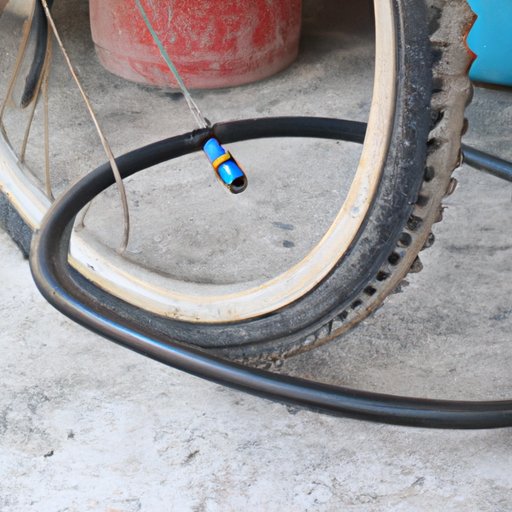
I. Introduction
Tire inflation is crucial for safe and efficient driving. Properly inflated tires help optimize handling, fuel economy, and reduce wear and tear on the tires. However, many people overlook this maintenance task until it’s too late. In this comprehensive guide, we’ll explore tips and tricks for inflating tires, how to use different types of air compressors, and discuss common issues when filling tires with air. With proper knowledge and tools, anyone can learn how to put air in tire efficiently and effectively.
II. The Ultimate Guide to Putting Air in Your Tires: Tips and Tricks
Checking your tire pressure at least once a month is recommended. Proper tire inflation maintains optimum handling, avoids uneven tire wear, and saves fuel. For this task, you will need a tire pressure gauge, a tire inflator, and an air compressor. The tire inflator can either be a portable 12-volt pump or a wall-mounted air compressor.
When filling your tires with air, it’s essential to check the manufacturer’s recommendations for the recommended PSI (pounds per square inch). Overinflated or underinflated tires can have serious consequences while on the road. An overinflated tire is more susceptible to cracking, while an underinflated tire will have more wear and tear.
When you begin filling your tires with air, follow these steps:
- Remove the valve cap and keep it in a safe place to avoid losing it.
- Attach the air chuck onto the valve stem and rotate it until the valve needle is depressed.
- Read the display on the tire pressure gauge to check the PSI level.
- If the pressure is low, fill the tire for a few seconds and recheck the pressure gauge. Repeat until you achieve the recommended level of pressure.
- When you reach the recommended PSI, remove the air chuck and replace the valve cap.
III. DIY Tire Inflation: How to Keep Your Tires in Tip-Top Shape
While it is preferable to go to a gas station or a mechanic to fill your tires, sometimes it’s just not possible. Fortunately, several easy methods can help you fill up your tires without any professional help. First, you need to purchase a tire pressure gauge and an air pump to fill the tires.
After attaching the air pump’s hose to the valve stem, use the pressure gauge to check the current PSI level. Once you achieve the recommended PSI, remove the hose and replace the valve cap. It’s that simple!
Additionally, investing in a valve replacement kit might help prevent future leaks. To replace the valve, you will need a valve key and a new valve stem. First, loosen the valve, unscrew it using the valve key, and insert the new valve stem. Tighten the valve tightly with the valve key.
IV. How to Use Different Types of Air Compressors for Your Tires
Four types of air compressors are commonly used for inflating tires: pancake, hot dog, twin-stack, and wheelbarrow compressors. Pancake compressors are portable and easy to use; however, they fill up air more slowly and produce less PSI. On the other hand, hot dog compressors weigh more and have a larger air storage tank. Due to their larger tanks, they produce more PSI and fill tires up more quickly.
Twin-stack compressors are typically used for heavier-duty tasks and have two air tanks. In contrast, wheelbarrow compressors are ideal for construction sites or other outdoor work environments.
To use an air compressor to fill your tires, connect the hose to the tire valve and adjust the pressure with the regulator knob. Turn the compressor on and fill up the tire until it reaches the recommended PSI. After that, turn off the compressor and disconnect the hose from the valve stem.
V. Troubleshooting Common Issues When Filling Tires with Air
Occasionally, problems can arise when inflating tires, causing the process to take longer than expected. Issues can stem from faulty gauges or worn tire components. When such issues arise, it’s essential to troubleshoot and fix them before proceeding to inflate the tires.
If the air compressor doesn’t turn on when you plug it into the outlet, ensure that the pressure switch is turned on, and the compressor motor is not damaged. Sometimes, gauges can be faulty; when gauges fail, it results in inaccurate readings or no readings at all. In this case, it’s best to replace your gauge.
For issues with tire valves, check if the valve is tightened, and replace it when it’s worn or damaged. Consider seeking professional help if you’re not confident in performing such tasks.
VI. How Frequently Should You Inflate Your Car Tires?
Driving conditions and environmental factors determine how often you need to inflate your tires. Tire pressure needs to be checked at least once a month, and if you frequently drive to different climates or long distances, you may need to adjust pressure accordingly. For seasonal changes when temperature differences affect tire pressure, consult the recommended pressure levels in the manual. High-performance tires require more frequent air fill-ups, while those with run-flat technology may have a different pressure level than usual tires.
VII. How to Properly Store a Tire Inflator: Quick Tips and Tricks
Proper storage is essential when it comes to tire inflators. Dirt and debris can accumulate on the hose or nozzle, leading to potential inefficiencies or even malfunctions. When not in use, store the inflator in a dry and clean environment to prevent rust and corrosion. Consider using protective covers for added safety.
VIII. Conclusion
Proper tire inflation is crucial for safe and optimal driving. To ensure proper pressure in your tires, check the pressure at least once a month. Use a reliable tire pressure gauge and air pump to fill up the tires efficiently, and troubleshoot any issues that may arise. Proper maintenance and storage of your tire inflator will ensure it’s functional whenever you need it. Remember, with careful attention and proper knowledge, anyone can learn how to put air in tire like a pro.




